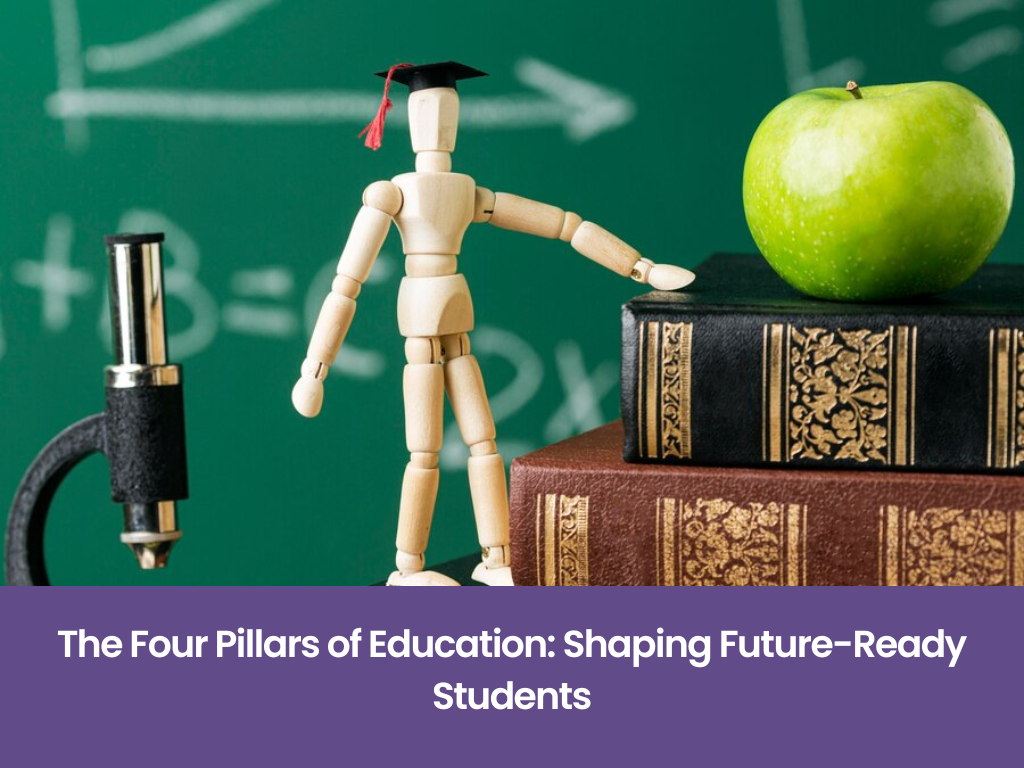The Four Pillars of Education: Shaping Future-Ready Students
posted on Nov 05, 2024
Discover the Four Pillars of Education – Learning to Know, Learning to Do, Learning to Live Together, and Learning to Be – and how they shape future-ready students with essential knowledge, skills, and values for personal and professional success.

In a rapidly evolving world, education must go beyond traditional knowledge transfer, aiming instead to develop adaptable, resilient, and future-ready students. The Four Pillars of Education, as conceptualized by UNESCO, provide a comprehensive framework for achieving this goal. These pillars – Learning to Know, Learning to Do, Learning to Live Together, and Learning to Be – emphasize holistic development, essential for students to navigate the complexities of modern life.
1. Learning to Know
Foundation of Knowledge Acquisition
"Learning to Know" is the foundation for intellectual growth, emphasizing the importance of knowledge acquisition and cognitive skills. This pillar encourages curiosity, critical thinking, and lifelong learning, equipping students with the mental tools needed to understand and engage with the world. It’s not just about memorizing facts; it’s about nurturing a genuine interest in learning and problem-solving, laying the groundwork for adaptability in an ever-changing landscape.
Strategies for Implementation:
- Integrated Curriculum: Encouraging interdisciplinary approaches helps students connect concepts across subjects, enriching their understanding.
- Critical Thinking Exercises: Problem-solving tasks and analytical discussions cultivate critical thinking skills, helping students learn how to approach complex problems.
- Lifelong Learning Attitude: Instilling a love for knowledge, exploration, and continuous learning primes students for growth beyond formal education.
2. Learning to Do
Application of Knowledge and Skills
In a world that demands practical skills, "Learning to Do" emphasizes the importance of translating knowledge into action. This pillar focuses on skill development, including technical and vocational skills, fostering employability and adaptability. From collaborative projects to internships, students are encouraged to gain hands-on experience, which sharpens their ability to apply knowledge in real-world situations.
Strategies for Implementation:
- Experiential Learning: Incorporating project-based learning, internships, and apprenticeships allows students to apply theoretical knowledge in practical settings.
- Skill-Based Training: Programs that focus on skill development, like coding, communication, and problem-solving, prepare students for the workforce.
- Emphasis on Soft Skills: Skills such as teamwork, adaptability, and communication are vital and should be woven into the curriculum.
3. Learning to Live Together
Promoting Peace, Tolerance, and Cooperation
"Learning to Live Together" is essential in today’s interconnected world, where collaboration and empathy are crucial. This pillar encourages students to appreciate diversity, understand different perspectives, and resolve conflicts peacefully. By fostering social skills, cultural awareness, and emotional intelligence, students learn to build harmonious relationships, crucial for both personal and professional success.
Strategies for Implementation:
- Diverse Learning Environments: Engaging with peers from varied backgrounds helps students embrace cultural diversity and inclusivity.
- Conflict Resolution Workshops: Teaching strategies for resolving disagreements peacefully promotes respect and cooperation.
- Global Citizenship Programs: Introducing topics like environmental awareness and social responsibility nurtures empathy and collective responsibility.
4. Learning to Be
Fostering Personal Growth and Self-Discovery
The most personal of the pillars, "Learning to Be" is about self-development and understanding one’s purpose. It encourages students to cultivate self-awareness, resilience, and moral integrity, equipping them with a sense of identity and emotional strength. This pillar underscores the importance of self-confidence and creativity, enabling students to lead fulfilling lives and make meaningful contributions to society.
Strategies for Implementation:
- Mindfulness and Well-being Practices: Incorporating mindfulness activities helps students manage stress, promoting mental and emotional well-being.
- Character Education Programs: Emphasizing values like integrity, responsibility, and empathy fosters personal growth and moral reasoning.
- Opportunities for Self-Expression: Encouraging arts, sports, and other expressive activities allows students to explore and build their unique identities.
Integrating the Four Pillars for a Holistic Education
For a holistic educational experience, these four pillars should be seamlessly integrated into the curriculum, creating a well-rounded learning journey. Schools and educational institutions must balance traditional academics with practical, social, and emotional learning to produce graduates who are not only knowledgeable but also capable, compassionate, and self-assured. In doing so, we can shape students who are ready to thrive in a complex world, equipped with the skills to adapt, innovate, and collaborate.
In a Nutshell..
We at the BGS Vijnatham School believes that the Four Pillars of Education serve as guiding principles for shaping future-ready students. By embracing "Learning to Know," "Learning to Do," "Learning to Live Together," and "Learning to Be," educators can empower students with the knowledge, skills, values, and resilience they need to succeed in a dynamic world. This approach not only prepares students for careers but also fosters well-rounded individuals who contribute positively to society. Through these pillars, education can transform lives, paving the way for a brighter, more inclusive future.